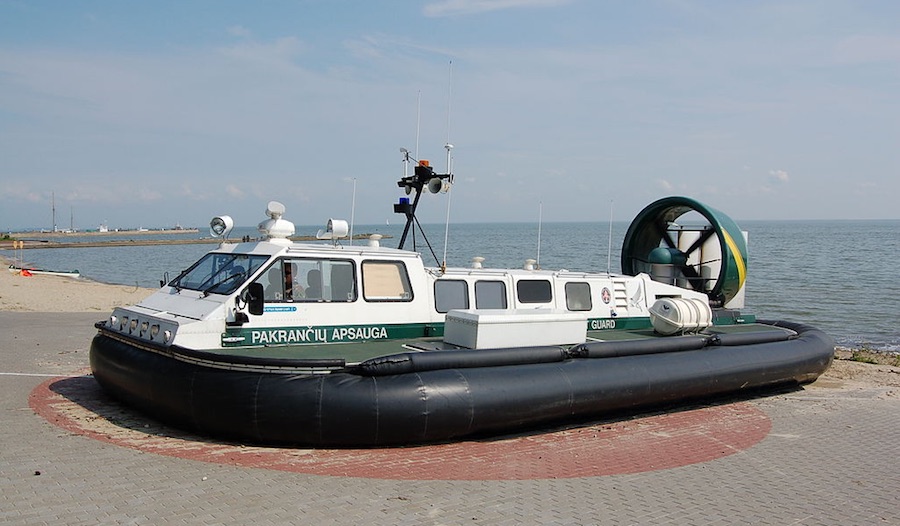
There’s cold, and then there’s FREEZING COLD. As far as plunging mercury goes, no Canadian mine can out-freeze Meadowbank.
The open-pit silver and gold mine in the northern Canadian territory of Nunavut sees an average temperature of -35.4C during its coldest month of the year. That’s even colder than Canada’s diamond mines, Ekati, Diavik and Snap Lake, which were ranked number two, three and four respectively in a 2014 survey gathered by IntelligenceMine – a division of InfoMine.
Now Agnico Eagle’s largest mine is hoping to reach another milestone with an unusual piece of exploration equipment: the hovercraft.
“The intent is to perform a one-year pilot program starting in the summer of 2017 continuing through the winter of 2017/2018 to validate its operational performance, to demonstrate its viability for search and rescue activities in the area around Meadowbank and to de-risk the later stages of a larger implementation strategy”
The Toronto-based gold miner announced recently that it is proposing to buy two hovercrafts that would be used for moving personnel and light cargo on winter roads and trails, on the Amaruq property year-round. On Friday Agnico Eagle’s board of directors approved the construction of two new gold mines in Nunavut – Meliadine and Amaruq, for a combined investment of $1.2 billion.
Meliadine is just north of of Rankin Inlet, while Amaruq is a satellite deposit of Meadowbank, located 110 km north of Baker Lake.
“The intent is to perform a one-year pilot program starting in the summer of 2017 continuing through the winter of 2017/2018 to validate its operational performance, to demonstrate its viability for search and rescue activities in the area around Meadowbank and to de-risk the later stages of a larger implementation strategy. Depending on the success and findings of the pilot study, the operation of these two hovercrafts is expected to continue beyond 2018,” Agnico Eagle states in a project summary submitted to the Nunavut Planning Commission in December.
The company notes that hovercrafts have solved many transportation logistics problems in Northern and Arctic regions, and that they be used amphibiously on water or land, including small and large rivers, lakes, swamps, snow soil, packed ice bogs, tundra, and coastal seas. With Agnico Eagle’s properties in Nunavut spanning a 400+ kilometre-long stretch, “improving the ability to move people and equipment more freely within this area would have an immediate and significant impact on the company’s long term strategy and success in Nunavut, primarily in the areas of logistics and exploration,” according to the hovercraft proposal.
Other miners are examining new and economical ways of supplying mines in remote locations. In November Quest Rare Minerals Ltd., (TSX:QRM) the company developing the Strange Lake rare earths mine in Northern Québec, Canada, and Straightline Aviation announced an agreement to provide air services for the transport of ore concentrate, supplies and personnel using Lockheed Martin’s hybrid airships. The airships will shuttle between Quest’s Strange Lake open pit mine in Northern Québec and Schefferville, a town with a direct rail link to the Port of Sept-Iles.
Along with constructing new mines, Agnico Eagle, which in 2015 was #9 on IntelligenceMine’s list of top 10 gold producers, is also aiming to develop mines in the Canadian Yukon territory.
The company announced Dec. 5 it has bought a stake in thousands of mining claims in the White Gold district originally owned by Shawn Ryan, the Yukon prospector whose unique soil sampling method turned him into a millionaire almost overnight.
Comments
Robin Paine
For those interested in these fascinating machines, there is a 700 page book, with 450 pictures called ‘On a Cushion of Air’, (available through Amazon and Kindle), which tells the story of Christopher Cockerell’s discovery that heavy weights could be supported on a cushion of low pressure air, and the development of the hovercraft by those who were there, from the very early days through to the heyday of the giant 165-ton SRN.4, which crossed the English Channel starting in 1968 carrying 30 cars and 254 passengers at speeds in excess of 75 knots on a calm day. It was subsequently widened to carry 36 cars and 280 passengers with an A.U.W. of 200 tonnes and was later lengthened to an A.U.W of 325 tons and capable of carrying 55 cars and 424 passengers. The amazing point was that from 165 tons to 325 tons only 400 extra hp on each engine was required, although a bit of speed was sacrificed, proving conclusively that Christopher Cockerell’s theory was sound.
There is also a 1 hour 20 minute DVD, ‘On a Cushion of Air’, based on the book available through Amazon Instant Video to rent or download.
Sadly, for economic reasons, the SR.N4 service came to an end on 1st October 2000. In total 6 SR.4s were built and the two remaining ones are in the Hovercraft Museum at Lee-on-Solent, England.